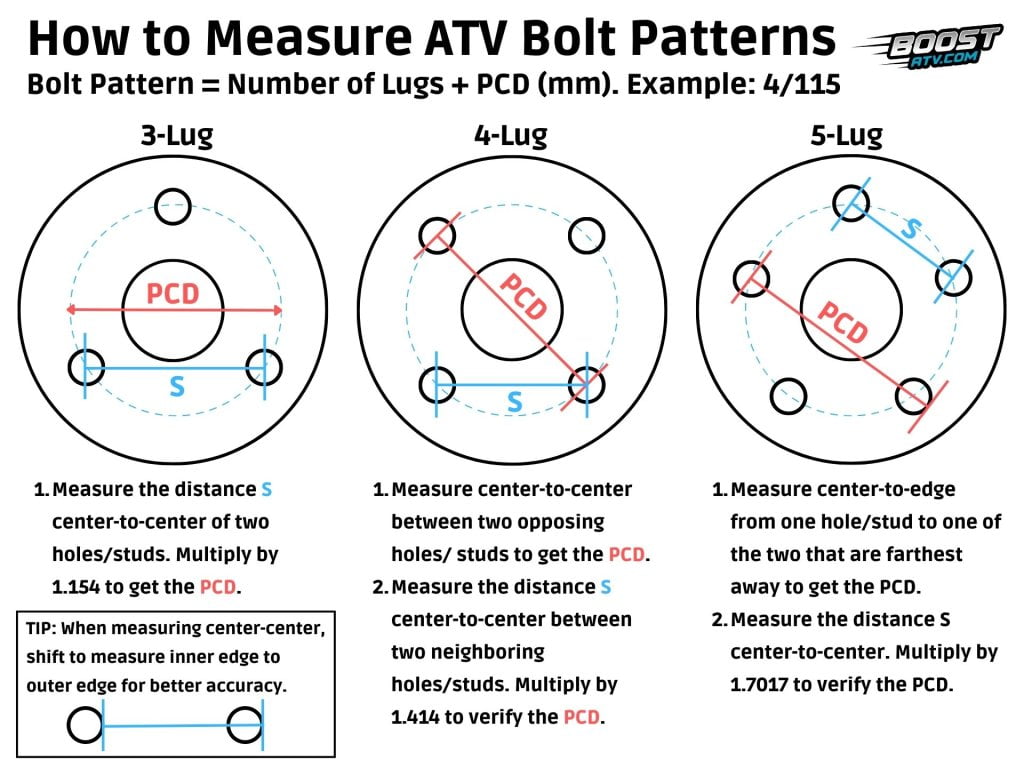Decoding Your Wheel's Bolt Pattern: A Comprehensive Guide

Ever wondered about those crucial bolts holding your wheels in place? They're not just random pieces of metal; they follow a specific arrangement known as the lug pattern, or bolt pattern. Knowing your vehicle's lug pattern is paramount for safe driving and proper wheel installation. Ignoring this critical aspect can lead to vibrations, premature wear and tear, and even dangerous wheel detachment.
So, what is a lug pattern anyway? Simply put, it's the configuration of the wheel studs or bolts on your vehicle's hub. It’s described by two numbers: the number of lugs and the diameter of the circle they form. For example, a common pattern is 5x114.3, meaning five lugs arranged on a circle with a diameter of 114.3 millimeters.
Determining your car's bolt pattern is essential when replacing or upgrading your wheels. An incorrect lug pattern can lead to improper fitment, jeopardizing your safety and potentially damaging your vehicle. Imagine driving down the highway and a wheel comes loose because the bolt pattern is wrong – a terrifying thought! Therefore, understanding this seemingly small detail can have significant implications.
Finding your car's lug pattern can be done in several ways. You can consult your owner's manual, look for a sticker inside the driver's side doorjamb, or sometimes even find it stamped on the back of the old wheel. Online resources and wheel retailers can also be helpful, especially if you know your vehicle's year, make, and model.
Understanding your wheel bolt pattern is not just about replacing wheels; it's about safety and maintaining the integrity of your vehicle. This seemingly small detail plays a significant role in ensuring a smooth, safe, and enjoyable driving experience. In the following sections, we'll delve deeper into the intricacies of lug patterns, exploring their history, importance, and how to determine yours accurately.
The history of lug patterns is tied to the evolution of the automobile itself. As cars became more sophisticated, so did their wheel and hub designs. Standardization was necessary for interchangeability and safety, leading to the development of various lug patterns. The importance of the correct lug pattern cannot be overstated. It ensures the wheel is centered correctly on the hub, distributing the load evenly and preventing vibrations. A mismatched pattern can lead to loose wheels, affecting steering and braking performance.
One common issue related to lug patterns is confusion between similar patterns. For example, 5x114.3 and 5x115 might seem interchangeable, but that small difference can have big consequences. Always double-check the exact measurement to avoid problems.
Benefits of knowing your correct lug pattern include ensuring proper wheel fitment, preventing potential damage to your vehicle, and most importantly, ensuring your safety on the road.
To determine your lug pattern, follow these steps: 1) Count the number of lug nuts. 2) Measure the diameter of the circle formed by the lugs (for 4 and 6 lug patterns, measure center-to-center of opposite lugs. For 5 lug patterns, measure from the back of one lug to the center of the opposite lug, and multiply by 1.051). 3) Combine the two numbers (e.g., 5x114.3).
Advantages and Disadvantages of Aftermarket Wheels (Related to Lug Pattern)
| Advantages | Disadvantages |
|---|---|
| Wider Selection of Styles | Potential for Incorrect Fitment if Lug Pattern is Ignored |
| Performance Enhancements | Cost |
Best practices: 1) Always consult your owner's manual. 2) Double-check measurements. 3) Buy wheels from reputable dealers. 4) Have a professional install your wheels. 5) Regularly check your lug nuts for tightness.
FAQs: 1) What is a lug pattern? 2) How do I find my lug pattern? 3) What happens if I use the wrong lug pattern? 4) Are lug patterns universal? 5) Can I change my lug pattern? 6) Where can I find information about lug patterns? 7) What tools do I need to measure a lug pattern? 8) How important is lug nut torque?
Tips and tricks: Use a caliper for accurate measurements. Consult online forums and communities for advice. Take photos of your current wheels for reference.
In conclusion, understanding your car's lug pattern is crucial for safe and proper wheel fitment. From ensuring proper wheel installation to preventing potential damage and ensuring your safety, knowing this seemingly small detail is vital. By following the steps outlined in this guide, you can confidently determine your vehicle's bolt pattern and make informed decisions about wheel replacements or upgrades. This knowledge empowers you to maintain your vehicle's integrity and enjoy a smooth, safe, and worry-free driving experience. Don't underestimate the importance of this small but significant detail. Take the time to identify your car's lug pattern – it's a small investment that can pay off big in terms of safety and peace of mind.
Your wells fargo card expiration a comprehensive guide
Free happy thursday greetings connecting in the digital age
Finding serenity with behr white paint featuring gray undertones













